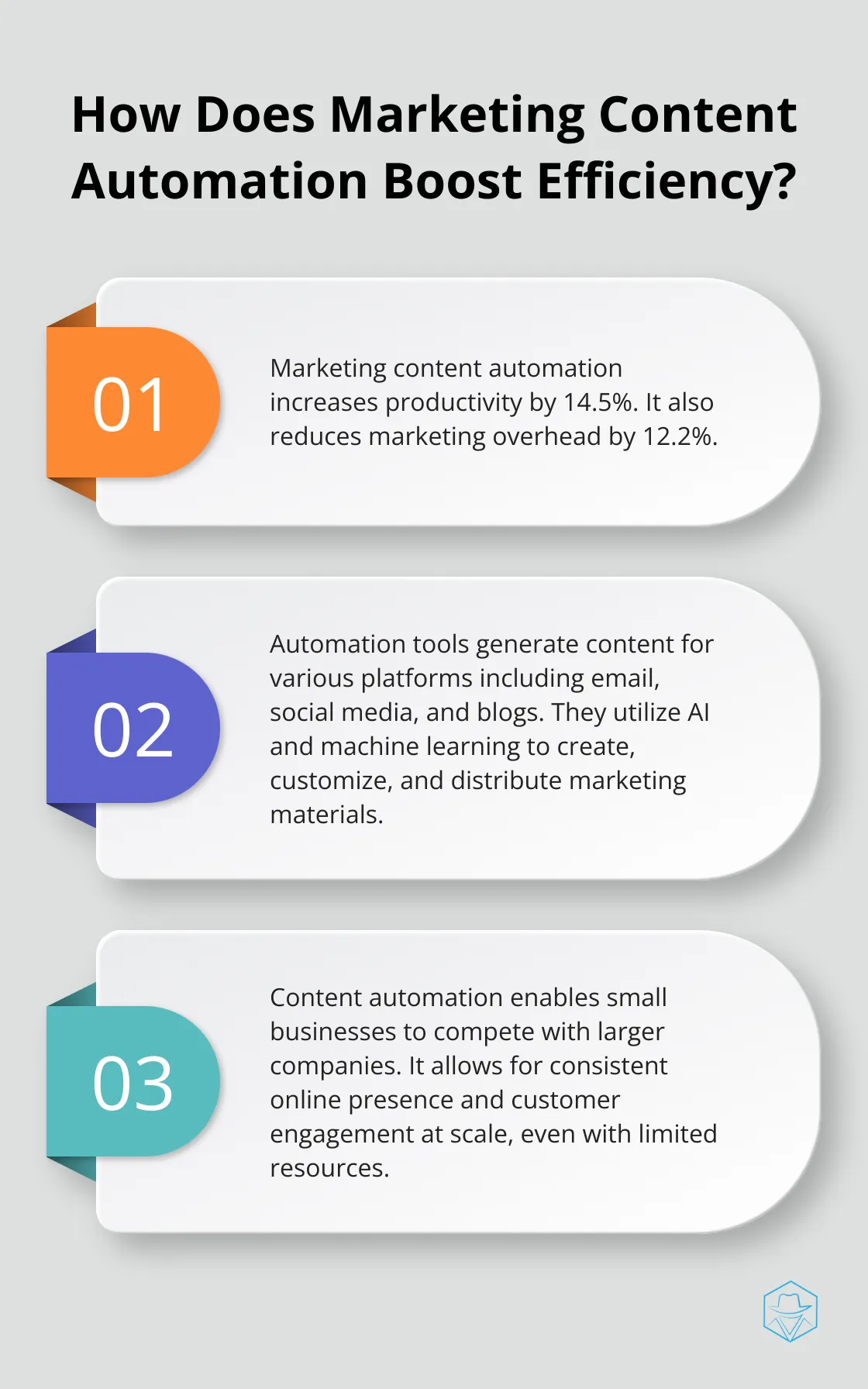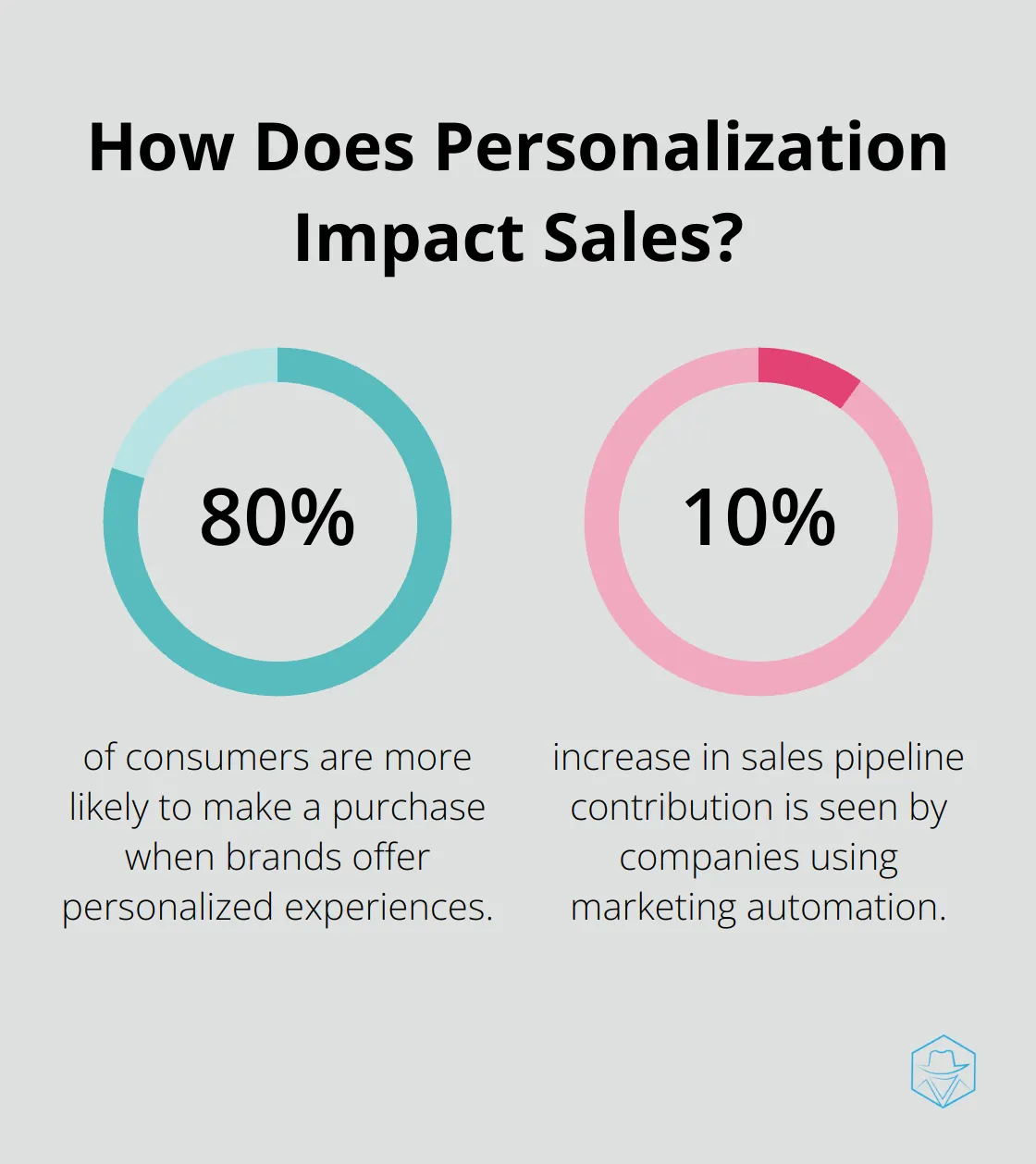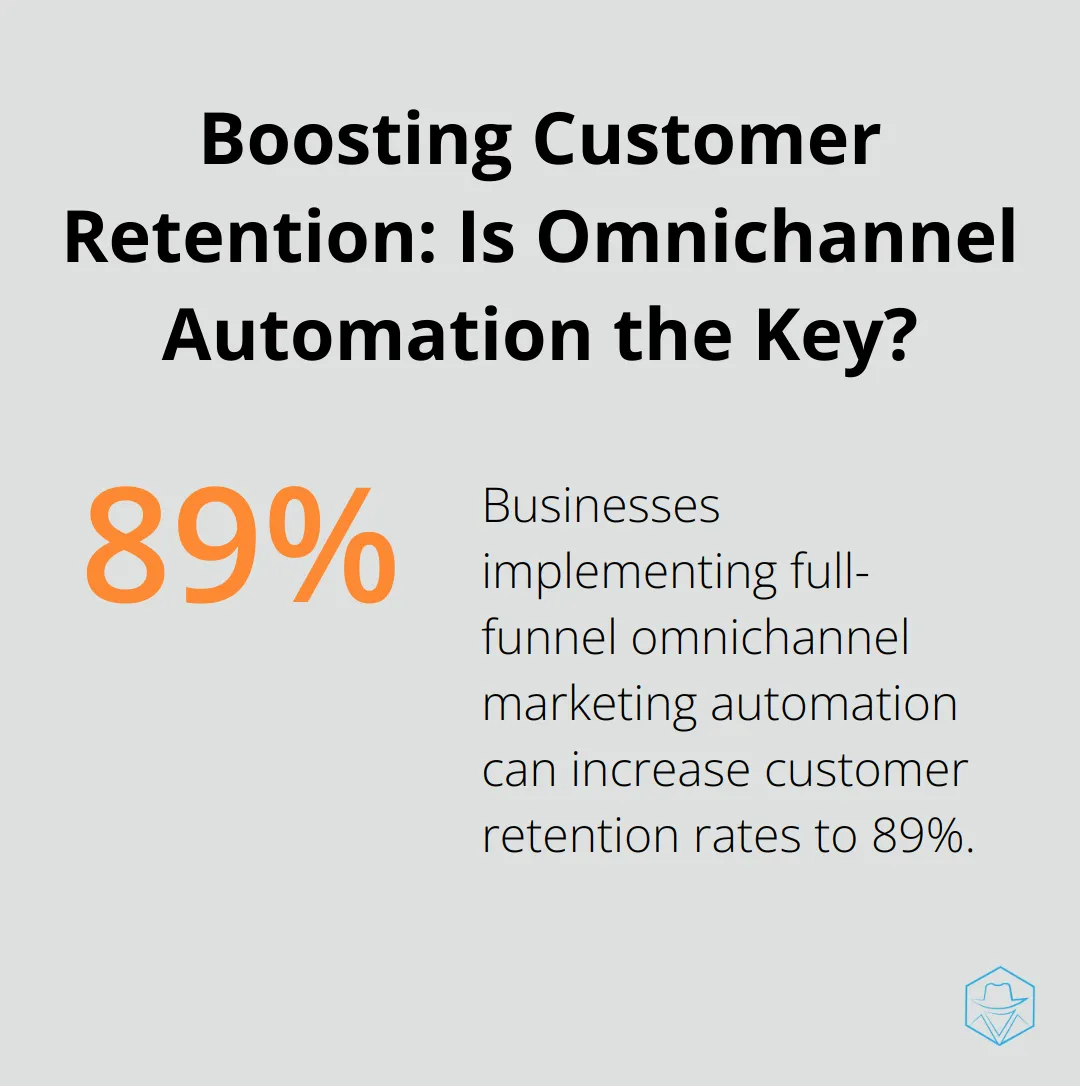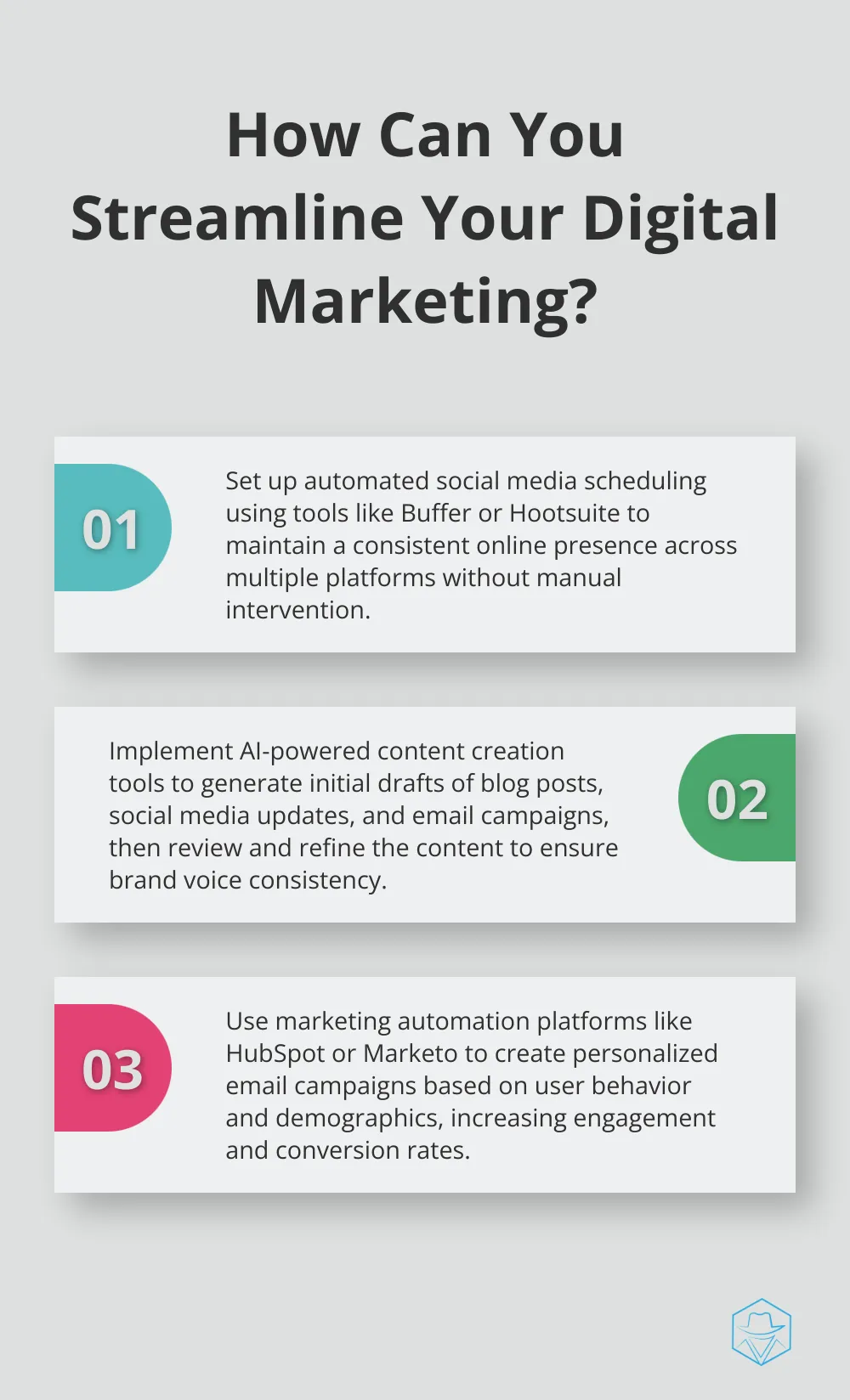Streamline Your Marketing Content with Automation

At Drop Cowboy, we’ve seen firsthand how marketing content automation can transform businesses. This powerful technology streamlines content creation, distribution, and analysis, saving time and boosting efficiency.
Marketing content automation isn’t just for large corporations; it’s a game-changer for companies of all sizes. In this post, we’ll explore how you can leverage automation to elevate your marketing strategy and drive better results.
What Is Marketing Content Automation?
The Core of Content Automation
Marketing content automation revolutionizes how businesses create, distribute, and analyze their marketing materials. It uses technology to handle repetitive tasks, which allows marketers to focus on strategy and creativity.

Content automation tools harness artificial intelligence and machine learning to generate, customize, and distribute marketing content across various channels. These systems can create email campaigns, social media posts, and even blog articles based on predefined parameters and data inputs.
Real-World Application
A real estate company might use automation to generate property listings. The system pulls data from a database and creates descriptions, selects appropriate images, and posts the listings across multiple platforms (all without human intervention).
Efficiency and Reach Amplified
The benefits of content automation are substantial. A study by Nucleus Research found that marketing automation can increase productivity by 14.5% and reduce marketing overhead by 12.2%. This translates to significant time and cost savings for businesses of all sizes.
Small businesses can level the playing field with larger competitors through automation. It allows them to maintain a consistent online presence and engage with customers at scale, even with limited resources.
Dispelling Automation Myths
Despite its benefits, some misconceptions about content automation persist:
- Myth: Automated content lacks personalization.
Reality: Modern automation tools excel at creating highly personalized content.
- Myth: Automation will replace human marketers.
Reality: Automation enhances human capabilities rather than replacing them. It handles routine tasks, which allows marketers to focus on high-level strategy and creative work.
The Power of Data-Driven Marketing
Content automation isn’t just about creation and distribution – it’s also about analysis. These tools provide valuable insights into content performance, which allows marketers to refine their strategies continually.
A/B testing becomes much easier with automation. Marketers can quickly test different versions of content and use data to determine which performs best. This data-driven approach leads to more effective marketing strategies over time.
As we move forward, let’s explore the key features that make content automation tools so powerful in today’s marketing landscape.
How Content Automation Tools Revolutionize Marketing
Content automation tools are transforming the marketing landscape, offering features that streamline processes and enhance effectiveness. These tools have a significant impact on marketing strategies across various industries.
AI-Powered Content Creation
Artificial Intelligence stands at the forefront of content automation. AI algorithms now generate blog posts, social media updates, and even video scripts. GPT-3 based tools produce human-like text, which saves marketers hours of writing time. (It’s important to note that AI-generated content should always undergo human review to ensure brand voice consistency and accuracy.)
Personalization at Scale
Personalization has become a necessity in marketing. Automation tools allow for dynamic content creation that adapts to individual user preferences, behaviors, and demographics. A study by Epsilon found that 80% of consumers are more likely to make a purchase when brands offer personalized experiences. Tools like Optimizely and Adobe Target enable marketers to create tailored content for different audience segments automatically.
Multi-Channel Distribution
Effective content distribution matches the importance of creation. Automation tools excel at scheduling and distributing content across various channels simultaneously. Buffer and Hootsuite (among others) allow marketers to plan and automate social media posts across multiple platforms. This ensures consistent brand presence and maximizes content reach without manual intervention.
Data-Driven Insights
One of the most valuable features of content automation tools is their ability to track and analyze performance. Tools like Google Analytics and Mixpanel provide in-depth insights into content engagement, user behavior, and conversion rates. This data enables marketers to make informed decisions and continuously optimize their strategies.

A study by Forrester Research indicates that companies using marketing automation see a 10% increase in their sales pipeline contribution. This statistic underscores the power of data-driven marketing enabled by automation tools.
While numerous automation tools exist, it’s essential to choose ones that align with specific marketing goals and integrate well with existing systems. The next section will explore how to implement these powerful tools effectively in your marketing strategy.
How to Implement Content Automation Effectively
Audit Your Current Workflow
To implement content automation effectively, you must first examine your existing content creation and distribution processes. Identify bottlenecks, repetitive tasks, and areas prone to human error. This audit will reveal prime opportunities for automation.

For example, if your team dedicates hours to manual social media post scheduling, that’s a clear candidate for automation. Similarly, if personalizing email campaigns consumes days, an automated solution could significantly reduce that time.
Select the Right Tools
The selection of appropriate automation tools is vital. Consider your specific needs, budget, and existing tech stack. Look for tools that integrate seamlessly with your current systems.
For email marketing automation, platforms like Mailchimp or Constant Contact offer robust features. Social media scheduling tools such as Buffer or Hootsuite can streamline your social presence. For more comprehensive automation, all-in-one platforms like HubSpot or Marketo are worth considering.
Don’t overlook specialized tools for specific tasks. For instance, Drop Cowboy’s Mimic AI™ technology automates personalized voice messages (a unique feature that can set your campaigns apart).
Best Practices for Integration
When you integrate automation tools, start small. Choose one or two processes to automate initially, rather than overhauling your entire workflow at once. This approach allows you to resolve issues and gain team buy-in gradually.
Ensure that your automated processes align with your overall marketing strategy. Automation should enhance (not replace) your brand’s unique voice and approach.
Data from Invesp shows that businesses implementing full-funnel omnichannel marketing automation can increase customer retention rates to 89%. This statistic underscores the importance of a holistic approach to automation.
Team Training and Adoption
The success of your automation efforts depends on your team’s ability to use the new tools effectively. Invest in comprehensive training for all team members who will interact with the automated systems.
Create clear documentation and standard operating procedures for your new automated processes. This step ensures consistency and simplifies the onboarding of new team members in the future.
Encourage feedback from your team during the implementation process. Their insights can help refine your automation strategy and identify areas for improvement.
Automation does not replace human creativity; it augments it. A study by Aberdeen Group found that businesses using automation tools for marketing report a 451% increase in qualified leads. This dramatic improvement results from freeing up human resources to focus on high-level strategy and creative tasks.
Final Thoughts
Marketing content automation has transformed how businesses approach their marketing strategies. This technology streamlines content creation, distribution, and analysis, offering unparalleled efficiency and effectiveness. The benefits include increased productivity, reduced costs, and the ability to deliver personalized content at scale.

Key features of content automation tools empower marketers to focus on high-level strategy and creativity. These tools handle repetitive tasks, which frees up valuable time and resources for more impactful work. As we look to the future, marketing content automation will continue to evolve with more sophisticated AI algorithms and enhanced personalization capabilities.
At Drop Cowboy, we understand the power of automation in marketing. Our platform offers innovative features like Mimic AI™ for personalized voice messages and Smart Delivery™ for efficient global message distribution. These tools, combined with our ringless voicemail and SMS capabilities, help businesses automate their campaigns while maintaining a personal touch (without sacrificing quality).
blog-dropcowboy-com
Related posts

March 21, 2025
Key Benefits of Marketing Automation Revealed
Explore key benefits of marketing automation for efficiency, increased ROI, and enhanced customer engagement. Transform your strategy with proven insights.

March 8, 2025
Integrating Ringless Voicemail API into Your System
Boost communication with our ringless voicemail API integration guide. Get practical tips and tools for seamless implementation and improved efficiency.

March 26, 2025
HubSpot vs Marketo: Top Marketing Automation Tools
Compare HubSpot vs Marketo to find the ideal marketing automation tool for your business. Discover which software best suits your needs and strategies.

March 20, 2025
Zoho Marketing Automation: Features and Advantages
Explore Zoho Marketing Automation features and benefits to streamline your campaigns and boost engagement effectively.

April 8, 2025
Branded Calling: What Is It and Why Does It Matter?
Explore the impact of branded calling on customer trust and engagement. Learn how this approach boosts recognition and differentiates your business.

March 29, 2025
B2B Marketing Automation: Driving Business Growth
Boost business growth with marketing automation for B2B. Explore strategies, drive efficiency, and enhance ROI through automated marketing solutions.